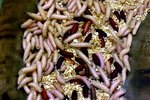
Earthworms are hermaphrodites: Unlike species that have male and female genders, earthworms are male and female at once. Every worm has both male and female organs, and produces sperm and eggs. Under favorable conditions they can breed at 6 weeks of age. That's one reason why earthworm populations grow rapidly when enough food and water are available to sustain them.
Basic Earthworm Reproductive Anatomy
The most obvious part of a worm’s reproductive system is the clitellum, the wide band near the head that’s thicker than the rest of the earthworm’s body. This is where the egg-holding cocoons get their start. Each worm also has male pores, situated between the clitellum and the head. These pores secrete sperm during mating. Female pores on the worm receive and store the sperm. Oviducts produce and release the eggs.
The First Steps
Despite that they produce both eggs and sperm, earthworms virtually always seek out a partner. Depending on species, they may mate on or near the surface of the earth, or may seek each other out further down inside the ground. Once two worms find each other they line themselves up side by side, with the head of one near the tail of the other. They press tightly together, and both worms excrete sperm packets from their male pores. The partner worms receive each other's packets and store them in their female pores.
Forming the Cocoon
Once they've transferred sperm packets, the worms go their separate ways. Each worm's clitellum secretes albumin, which forms into a cocoon as it slides down the outside of the worm. During this process, both the sperm and the eggs are encased in the albumin cocoon, at which point fertilization takes place. The cocoon starts to shrink, and the worm backs out of it, leaving the fertilized eggs inside. As soon as the worm is out, the cocoon seals itself.
The End of the Cycle
The tiny cocoon, no bigger than a grain of rice, is shaped something like a tiny lemon. Once it drops off the parent worm, it remains in the soil for a few weeks or up to two months or more. When the eggs have developed, they’ll hatch; as many as 20 but as few as one or two threadlike babies will emerge. If environmental conditions aren’t suitable, the eggs can remain dormant for months or even years before they hatch.
References
- Texas A&M University Aggie Horticulture: Home Worm Production
- Washington State University: Whatcom County Agriculture: Composting With Redworms
- University of Illinois Extension: My Anatomy: How Worms Reproduce
- University of Minnesota Great Lakes Worm Watch: Learn Worm Anatomy and Biology
- New Mexico State University Cooperative Extension Service: Vermicomposting
- NC State University: Vermicomposting: Earthworms and Worm Bins
Photo Credits
-
Ryan McVay/Photodisc/Getty Images



